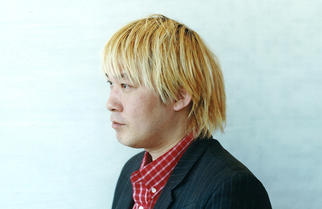
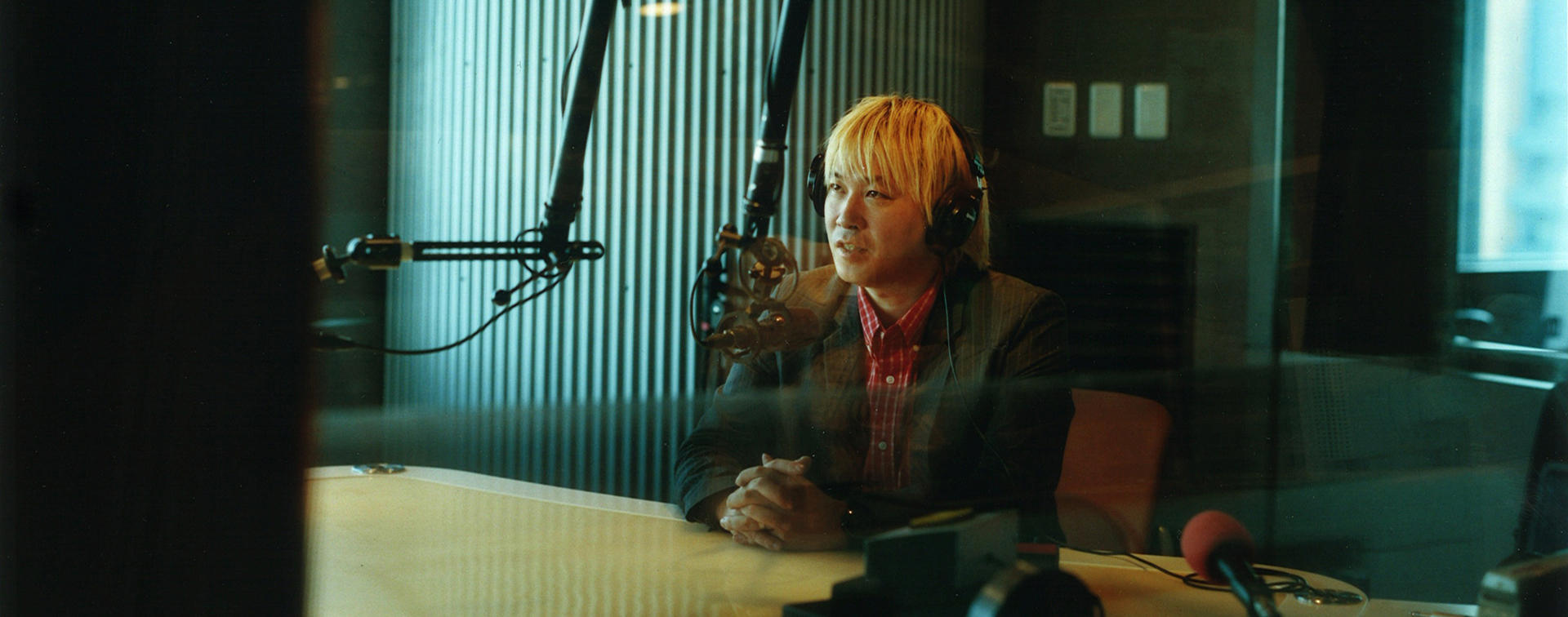
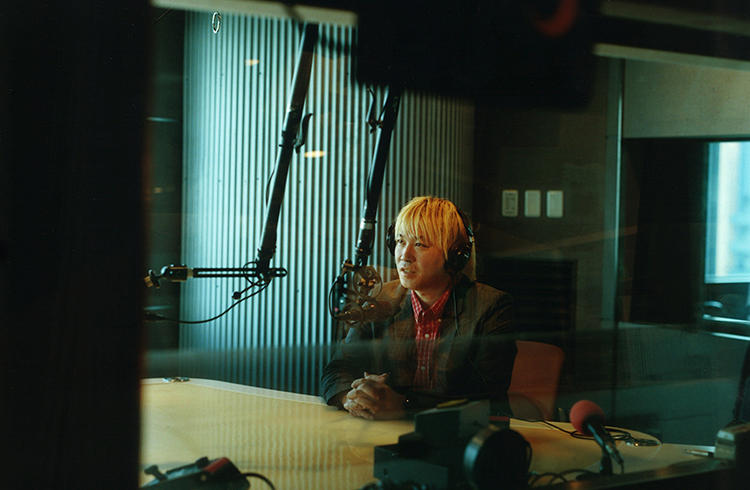
How would you turn Roppongi into an area of Design & Art?
Posing questions to society through art, design and media
- JP / EN
Having foreseen the potential of Twitter and the Internet, Daisuke Tsuda has utilized these forms of media in his own distinctive way. Besides the Internet, Tsuda has recently expanded his activities in radio and TV; he is the personality every Tuesday on the J-WAVE "JAM The World" program. The recording of the program takes place in a studio with a breathtaking view on the 33rd floor of Roppongi Hills Mori Tower. Tsuda told us that his ties to Roppongi have deepened since he comes to the studio in Roppongi every week. We asked him about his visions for this area.
Art that makes the viewer think
Just the other day, I went to Chernobyl on a research trip for a magazine. I visited the Ukrainian National Chornobyl Museum in Kiev, the capital of Ukraine. The museum had a lot of impact; the way they designed the space, and displayed the items was very three-dimensional and artistic. I suppose everyone knows about the nuclear accident that occurred in Chernobyl in 1986. The museum is designed so that when you go from the entrance and climb the stairs, the higher you go, the closer you get to the nuclear plant. And there are hanging road signs representing the roughly 70 villages whose residents were unable to return. On the ceiling is a world map where the shining lamps indicate the places where nuclear plants are located. There was also an art object made from stuffed toys that the children had left behind.
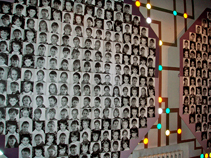
Ukrainian National Chornobyl Museum
A museum set up in Kiev, the capital of Ukraine, with the aim of telling future generations of the Chernobyl nuclear accident. It was established sixth years after the April 26 1986 accident at the Chernobyl Nuclear Power Plant. While giving informing about the tragic event, the museum has a visual impact that leaves a lasting imprint on the minds of visitors.
In Japan, we have the Hiroshima Peace Memorial Museum and the Okinawa Prefectural Peace Memorial Museum which are also facilities that inform people of the tragic events of the past. In Japan, though, the exhibitions tend to be focused on documenting and offer a lot of explanation. I would not say that the museum in Chernobyl is entertaining, but I got the impression that about 30% was documentary, and 70% was experience-oriented installations and artistic displays which were based on archives; the content is designed to make people think. There are materials that tell about the accident itself, and there are displays that pose philosophical questions, and there is a very fine balance between the two. I heard that the exhibition is produced by the local artists.
Posing stimulating questions to society
Art is something that prompts people to think about things. That was on my mind during the "The End of the World" exhibition held last year at the National Museum of Emerging Science and Innovation last year. The subtitle of the exhibition was "73 Questions We Must Answer". It really was an exhibition that asked a lot of questions and it was very interesting. I realized then that cutting-edge art and designs are about asking front-line questions. I heard that the exhibition had a record-setting number of visitors.
The Makoto Aida exhibition at the Mori Art Museum in Roppongi created controversy but it was ultimately a great success. I think the reason is that it posed stimulating questions to society.
I think that areas of design and art are essentially areas that are constantly asking questions. Tokyo Midtown and Roppongi Hills have aspects that are symbolic of consumer society, but it would be interesting if these places posed questions such as "Is it okay for consumer society to continue like this?" Without saying "no" to the contradictions of capitalism, the contradictions could be shown as they are. That kind of thing would draw people, and I have a feeling that it would make Roppongi a place for new happenings and encounters.
Art, design and media
I think that we need not only art and design, but also the media. A lot of the major newspaper companies are located near Otemachi or near the government offices, but I feel it would be good if companies in mass media and journalism had their offices in Roppongi. I'm keen to see how journalism and art and design could combine, and I feel that my own activities lie in that area.
I gained attention because of Twitter. I was listening to a government council from the visitors' gallery; the discussions were about something I would have liked the mass media to report, but there were no reporters in the reporters' seats. So I used Twitter - a tool for reporting the things that are happening now - to report on the council. It was fun, and I thought there was potential in it, so I began reporting on the spot from all kinds of press meetings.
So the motive was journalism, but I think I was also partly experimenting to see what journalism would be like using Twitter; to me, it felt like a kind of art activism. There was no one in the world using Twitter for reporting so I thought I might as well be the first person to do it.

A place that draws people looking for new ways of expression
Using new media, or new tools and methods, and seeing how you can express yourself with them, is something that is taken for granted in the world of music. When new musical instruments were made, the sampler came about and hip hop music was born, and new methods such as using recorded music led to the creation of techno music. I was originally a writer for a magazine. I began using Twitter in 2007 which was about the time that magazines increasingly stopped being published. It was a time when I was wondering what kind of things could be done by using new media.
I think this kind of thing happens in other genres too. A new technology emerges, and a new form of expression using that technology is born. It would be interesting if people looking for new expressions gathered in large numbers in Roppongi. I think for that to happen, you need a "place."
A real-life place in Roppongi that can serve as a base
The "Academy Hills" on the 49th floor of the Mori Tower is a place I am fond of. Being an instructor at a business seminar called "Let's Note Business Skill-up Academy", I've been going there often these last two years. Shared offices and co-working spaces are now very popular, but Academy Hills had this kind of space 10 years ago. Because of that, I always thought, "Roppongi Hills is rather cool. Roppongi as a whole is cool."
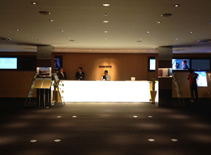
Academy Hills
A space on the 49th floor of Roppongi Hills Mori Tower. With the theme of providing "intellectual activities to city dwellers", the facilities are comprised of a school, a library and a forum. The architectural design is by Kengo Kuma.
The nice thing is the location of Roppongi and its atmosphere, and the fact that because it's a real place you can meet people. It was at Academy Hills that I met religious scholar Hiromi Shimada-san. I'm an Internet person, and though I'm not saying we should go back in time, I do feel that real places have their advantages. On the Internet, there are times when you can get too deeply involved with people, and I realized that it's important to be connected to the people who are genuinely interesting.
So I think it would be good if there was a place in Roppongi similar to the "Academy Hills" but which could be used more cheaply, and which freelance writers like myself could casually use as a base.
Roppongi is close to Nagatacho and Kasumigaseki
In fact, I'm thinking of making such a place myself. It's just a dream at the moment, but I'm hoping to make a shared office for co-working where small events could be held. I would like to move my own office there and at the same time make it available for as a co-working space for freelancers. It would be great if it had a bar counter. I'm thinking of having the place in Akasaka which is near Roppongi; I've begun by looking at real estate.
The biggest appeal about Akasaka is that it's close to Nagatacho and Kasumigaseki. I think I find Roppongi attractive because it is close to Kasumigaseki.
In the last two or three years, my biggest interest is politics. With the proliferation of the Internet, politics has become closer to us than ever before. My personal involvement in political activities has also increased, and I sense a physical closeness to politics. The anti-nuclear protests held in front of the prime minister's office were very active until last year; even after that, I've called on people to talk more about nuclear plants, and we've had meetings in Roppongi. The good aspect of Japan, or rather of Tokyo, is that it's possible to do that kind of thing.
Shared office
An office that is shared as working space by several users. When people from different fields get together, a network can be formed, creating more opportunities for new ideas.
Demonstrations in front of the prime minister's office
Anti-nuclear demonstrations that have been held since the nuclear disaster on March 11 2011. The demonstrators gather to protest every Friday around the Diet building and the prime minister's office in Tokyo's Nagatacho.

Tokyo - an amazing city with a big capacity for compassion
The other day, on "JAM The World" program which I host, I was talking to Hiroya Yoshizato-san of "Real Tokyo Estate" and I realized once again how amazing the city of Tokyo is. I'm from Kita City in Tokyo, and when I go to regions outside of Tokyo, people tend to say things like "There is no compassion in Tokyo." But I don't think that's true at all. I think that actually there is no other place like Tokyo that is filled with so much compassion.
JAM THE WORLD
A radio program broadcast on J-WAVE every week from Monday to Friday 20:00-21:50. Its concept is "to read the news and relay the sensibilities." Daisuke Tsuda hosts the program every Tuesday.
And people don't interfere. They don't interfere, but they have compassion. In Tokyo, when you have a problem, somebody will help you as long as you have a proper network. In the countryside, human relationships may be close, but people interfere, and there are times when you come to a dead end, and can't go any further. But in Tokyo, there is greater capacity; the connections may be weak, but there is compassion. This city has a big capacity of compassion, and I'm very keen to see how we can make small communities within it for like-minded people.
Berlin - a pleasant city with plenty of greenery
Of the cities abroad that I've visited, Berlin was impressive. In the middle of the city there are buildings like those of Roppongi Hills, but right nearby, there is also a park. It's such a huge park that Mori Teien doesn't even compare with it. And there are many other parks in Berlin. When a site is to be redeveloped, they apparently hold a local vote and because the results show that the number one wish of the residents is to build a park, the greenery keeps on expanding.
With the reunification of West Germany and East Germany, Berlin became a capital, but many of the former West German companies didn't move their headquarters to Berlin, but kept them in Frankfurt and Bonn. So Berlin apparently has a low level of tax revenues; it's the capital city but it's poor. Nonetheless, it's wonderful that it's such a pleasant town. What's more, it's possible to move around on a bicycle. You can carry bicycles onto the subway train, and it's splendid in the warm seasons from July to around September.
10 more things left to do
I've been working for about 16 years; my work seems to change every two or three years. I started out as a writer and became independent in two years, starting a small editing production company. About three years later, I began writing a blog, and two years after that, I became a journalist. Along the way, I've been doing social activities and have also set up a news site "Natalie".
In November this year I'll be turning 40. If I were to work until the age of 60, doing something new every two years, it means there are 10 things left for me to do. One of them would be to create political media on the Internet. I'm actually engaged in doing that right now; last year I published a book called "Using the Web to influence politics." I'm also putting energy into activities for the House of Councilors election in July this year. The other thing I want to do is what I talked about earlier - creating a shared office or something similar. That means that there are only eight things left I can do. The question is how to make my choices... Well, the things I want to do increase every year, and I have a feeling that I might be able to do more. (laughs)
Editor's thoughs
We interviewed Tsuda-san at the J-WAVE studio. The photo session took place in "Studio A" which is used for the "JAM The World" program. Looking down from the window at the panoramic view of daytime Roppongi, Tsuda-san told us that during the program, he sometimes talks on topics such as poverty while seeing the colorful nighttime view of Roppongi. "I always feel conflicted, asking myself if it's alright to read the news in this kind of environment," he said. His words left an impression on me.(edit_rhino)
Informaiton
J-WAVE's 25th year
J-WAVE is a Tokyo-based FM radio station broadcasting on 81.3 MHz. Established in Nishi Azabu in 1987, it later moved to the 33rd floor of Roppongi Hills Mori Tower. To mark its 25th anniversary this year, a special acoustic concert at the Ryogoku Kokugikan Sumo Arena, commemorative programs, and various other events are planned.




